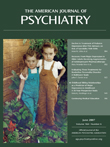Drs. Sijbrandij and Olff Reply
To The Editor: Drs. Varma and Parashar comment on our randomized controlled trial in which we compared the administration of four sessions of CBT in patients with acute PTSD with a comparison group on a waiting list. Drs. Varma and Parashar argue that placing the comparison group on a waiting list did not adequately control for nonspecific factors that might have influenced outcome. We assume that they are suggesting that we should have included a treatment group that received only supportive counseling without specific CBT contents. However, we feel that an untreated comparison group on a waiting list is the best comparison group because it is the closest to studying natural recovery. Since it has been repeatedly shown that some early interventions impede natural recovery rather than promote it (1) , comparison with an untreated comparison group is essential in trials evaluating the efficacy of early interventions. Moreover, since randomized controlled trials comparing early treatment of PTSD relative to a natural recovery comparison group are somewhat scarce (e.g., 2 , 3) , studies evaluating the potential benefits or risks of any intervention relative to no intervention at all in the immediate aftermath following trauma are still necessary.
Second, the authors comment that we did not perform screening for axis II disorders, specifically for borderline personality disorder. Indeed, performing extensive screening for personality disorder would have meant a significant burden for participants in our trial. We did, however, exclude patients with complex or chronic PTSD and risk for suicide. Therefore, the possibility of inclusion of many patients with borderline personality disorder influencing treatment outcome is implausible. Furthermore, we did not find an interaction effect between prior traumatic experiences—known to be present in many patients with borderline personality disorder—and treatment response in our exploratory subgroup analyses. In conclusion, we feel that any influence of the presence of borderline personality disorder on the efficacy of CBT in our study is highly unlikely.
1. Sijbrandij M, Olff M, Reitsma JB, Carlier IVE, Gersons BPR: Emotional or educational debriefing, a randomized controlled trial. Br J Psychiatry 2006; 189:150–155Google Scholar
2. Bisson JI, Shepherd JP, Joy D, Probert R, Newcombe RG: Early cognitive-behavioural therapy for post-traumatic stress symptoms after physical injury: randomised controlled trial. Br J Psychiatry 2004; 184:63–69Google Scholar
3. Ehlers A, Clark DM, Hackmann A, McManus F, Fennell M, Herbert C, Mayou R: A randomized controlled trial of cognitive therapy: a self-help booklet and repeated assessments as early interventions for posttraumatic stress disorder. Arch Gen Psychiatry 2003; 60:1024–1032Google Scholar



